Carpenter frogs, also known as Sphagnum frogs, are often confused with northern green frogs, American Bullfrogs, southern leopard frogs, and pig frogs due to similarities in physical characteristics and behaviours. But are Carpenter frogs good pets for beginners? Let’s find out.
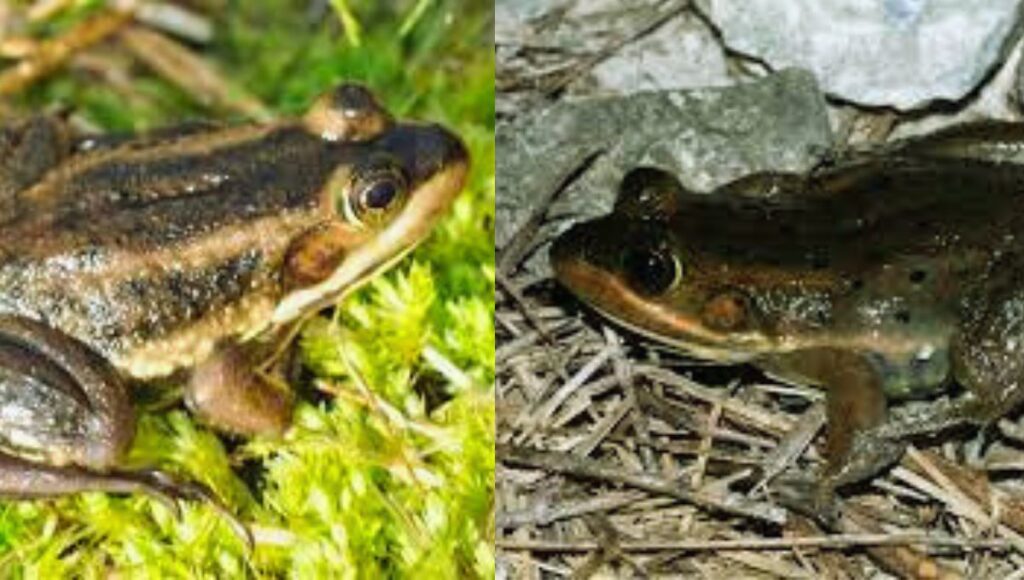
Table of Contents
Everything About Carpenter Frogs:
In a Glimpse:
| Common Name | Carpenter Frogs |
| Scientific Name | Lithobates virgatipes |
| Other Names | Sphagnum frogs |
| Maximum Length | 1.5-2.6 inches |
| Maximum Weight | N/A |
| Ranges | North America |
| Habitat | Warm and moist wetlands |
| Diet | Carnivore |
| IUCN Status | Least Concern |
| Lifespan | 2-3 years |
Geographical Range:
Carpenter frogs are a species of true frogs that are endemic to coastal plains of the Atlantic coast of the United States. These frogs are found from New Jersey to southern Georgia and northernmost Florida. However, they are also spotted in patches in Carolina.
Habitat:
Carpenter frogs are found in wide ranges of habitats such as the Pine Barrens of New Jersey to the Swamp region of southern Georgia. The frogs are usually found in artificial lakes, temporary and permanent pools, flooded lowlands, swamps, and pine-barren ponds. These true frogs prefer still, slow-moving, acidic, and shallow water with an abundance of aquatic vegetation, such as Sphagnum moss. Thus, these frogs are also known as Sphagnum frogs.
Aquatic vegetation in shallow water is very important for these amphibian species because the vegetation provides them with a place to hide and breed. However, you can find these frogs completely out of water but they don’t usually go very far from the water source. In some places, Carpenter frogs share habitat with Pig frogs.
Physical Description:
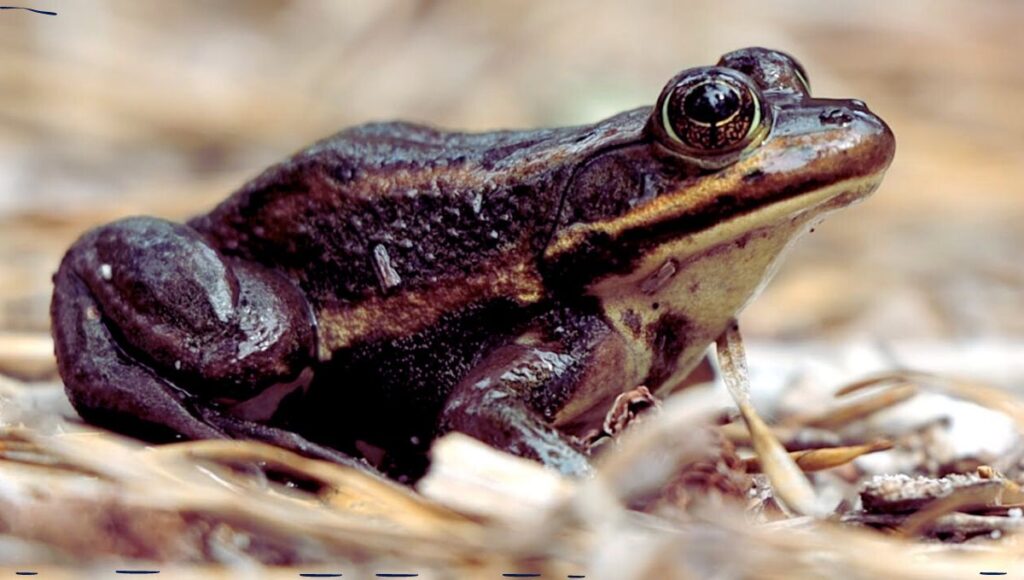
The medium-sized frog species are distinguished by the brown colour dorsum with two yellow stripes on the back. They have white or yellow underbelly with dark black mottling patterns and grey tails. Carpenter frogs have webbed toes but unlike other frogs, the webbing doesn’t reach their longest toes.
Carpenter frogs are 1.5-2.6 inches (4-6.6 cm) long, with a brown head, body and legs. Sexual dimorphism is present among the frogs as males have narrower heads than females. A line is present on their upper lips and they have a pair of throat pouches that look spherical if inflated. These frogs have ectothermic, heterothermic, and bilateral symmetry.
The tadpoles are also large and similar to the adults they are also brown with white underbellies, and The tail has dark stripes that run longitudinally through the musculature.
Defence Mechanism: Are Carpenter frogs poisonous?
Carpenter frogs are known as a secretive species. The true frog species secrete a toxic substance from their skins that can cause harm to humans, cats, dogs, and other animals. As a part of their defence mechanism, the frogs show camouflage techniques. It is said that these frogs are often found in tea or coffee-coloured environments where they can easily show camouflage.
Behaviour:
Carpenter frogs are usually nocturnal, solitary, and carnivorous by nature. These frogs exhibit camouflage to defend themselves from predators and very difficult to catch them in tea or coffee-coloured surroundings.
Aggressiveness:
Carpenter frogs are not aggressive, unlike other frog species in that region. They are shy by nature and often avoid confrontations by darting away underwater and raising their head after a while to reevaluate the situations. When the frogs are in water, only their heads can be seen from outside. But the frogs can be very aggressive during breeding seasons over mating rights.
Vocalizations:
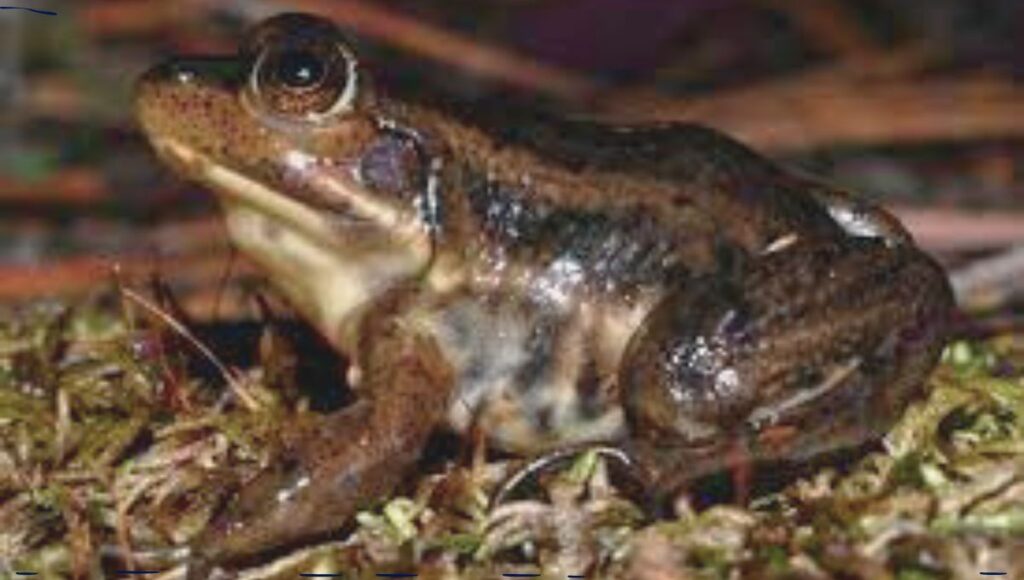
The call of an individual Carpenter frog sounds like two carpenters hammering a nail one fraction of a second after each other. When the frogs call in chorus, it sounds like a crew of carpenters hammering, and thus their common name originates from. Males can emit the call ten times in succession and this specific call is also known as “pu-tunk, pu-tunk, pu-tunk”.
Apart from pu-tunk, there are also five different types of calls that these frogs often use. Three of them are very loud and aggressive calls which are mainly used during fights, when one male grabs another male frog. The fourth call is a light call used by males following their aggressive calls to attract their female partners for mating. The fifth one is a chirp reply call used by females to show their agreement for courtship.
Physical Activities:
Carpenter frogs usually don’t prefer to run or climb trees. When they are frightened, they jump into the water and re-examine their surroundings by keeping their head out of the water. The frogs usually move on the ground by leaping and hopping. Additionally, due to their webbed toes, these frogs are excellent swimmers, however they prefer shallow water to live rather than deep water.
Diet:
Carpenter frogs are opportunistic predators and completely carnivorous. They feed on insects and invertebrates, such as spiders, crickets, worms, smaller frogs, fruitflies, and small fishes (occasionally). However, the tadpoles show an omnivorous nature as they can consume algae and moss. However, it is not confirmed yet if these frogs show cannibalism.
Predators and Threats:
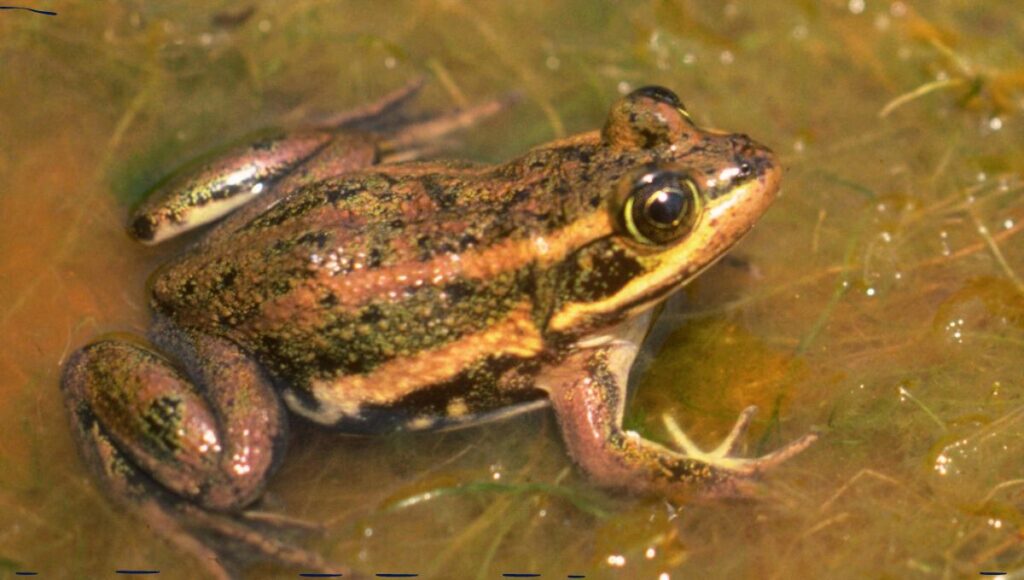
It is very difficult to catch and hunt Carpenter frogs due to their camouflage skills and skittish nature. However, in the wild, Water snakes, and bigger frogs such as American Bullfrogs, Green frogs, Pig frogs, alligators, prey birds, and other aquatic animals are their main predators.
Apart from the natural predators, these frogs suffer from many anthropogenic challenges such as habitat loss and climate change. The degradation of forests and wetlands in Georgia and New Jersey hurt their wildlife populations. Increasing human populations, ditching, urbanization, and also injecting fresh water in the waterbodies due to agriculture become a big threat to Carpenter frogs as they thrive in acidic aquatic environments.
Conservation Status:
The medium-sized American frog species are listed as “Least Concern” in the IUCN Red List of Threatened Species, but it is also mentioned that their population trend in the wild is still unknown.
Lifespan:
Carpenter frogs can live 2-3 years in the wild but in captive care, the longest lifespan that was documented so far is 6 years and 2 months.
Are Carpenter frogs good pets?
Carpenter frogs are a very unusual choice for pets but they can be an exotic choice for you. Keeping the true frogs is not recommended for beginners as these frogs require a certain environment to survive. Once you set up their habitats and environments, it is not very difficult to care for them as they are low-maintenance frogs as well, and due to their shy nature, they won’t trouble you much.

Carpenter frogs need aquatic vegetation with a warm environment to thrive. The pH level of water in the container should be less than 7 (slightly acidic) because these frogs prefer little acidic water to grow and regulate their daily activities. Additionally, these frogs are secretive by nature, hence you need to handle them very carefully.
Being nocturnal, these frogs emit a very loud call during the night which is very noisy and similar to a carpenter hammering nails. If you keep a bunch of these frogs, they can make a chorus that will sound like a crew of workmen hammering nails one after another, which may hamper your sleep at night.
Hence, it is advised to beginners to stay away from Carpenter frogs because it might be difficult and tricky for them to maintain their requirements such as controlling the pH level of water, maintaining temperature, cleaning the aquatic vegetation in the container, etc.
How do you buy a Carpenter frog?
It is very difficult to find them in pet markets but they may be available in illegal pet markets which are illegally captured. Hence, it is advised not to purchase any kind of frogs from illegal pet markets because not only does it encourage illegal capturing of frogs from the wild but also their health conditions are questionable.
You can buy Carpenter frogs either from a reputed pet shop or from a breeder who can ensure that the frog is born and raised in captivity. You can also check online platforms for buying but first check their reviews, policies, and other information before buying. Ask for proof of origin and health certificate while buying these frogs. However, you may visit an animal rescue centre, where you may find a Carpenter frog at a very cheap price (but health conditions are questionable).
Requirement and Care:
Enclosure:
A ten-gallon terrarium tank with a secure lid and proper ventilation will be perfect for the Carpenter frog. The enclosure must be eco-friendly and made of non-toxic elements for the frogs. A glass tank with a transparent view will allow you to monitor the frog.
Being an aquatic frog, these frogs need a lot of acidic water to survive. 70-80% of the container should be filled with water and aquatic vegetation that provides them a place to hide and breed. The remaining 20-30% area should be land area where the frog can rest and spend some time without water.
You need some live or artificial plants inside the terrarium that will make Carpenter frogs more comfortable with the environment. Artificial plants are a better choice because they are easy to clean and don’t create organic waste in the tank.
Substrate:
Carpenter frogs require a very moist environment to thrive and you need a substrate that can hold moisture for a long time. You can use coco fibre, soil, a mixture of coco fibre, or soils as a substrate. Natural substrates are best because you can plant live vegetation on them but artificial substrates are equally good and safe enough for the frogs. The only problem with artificial substrate is you can’t plant live plants in that artificial substrate.
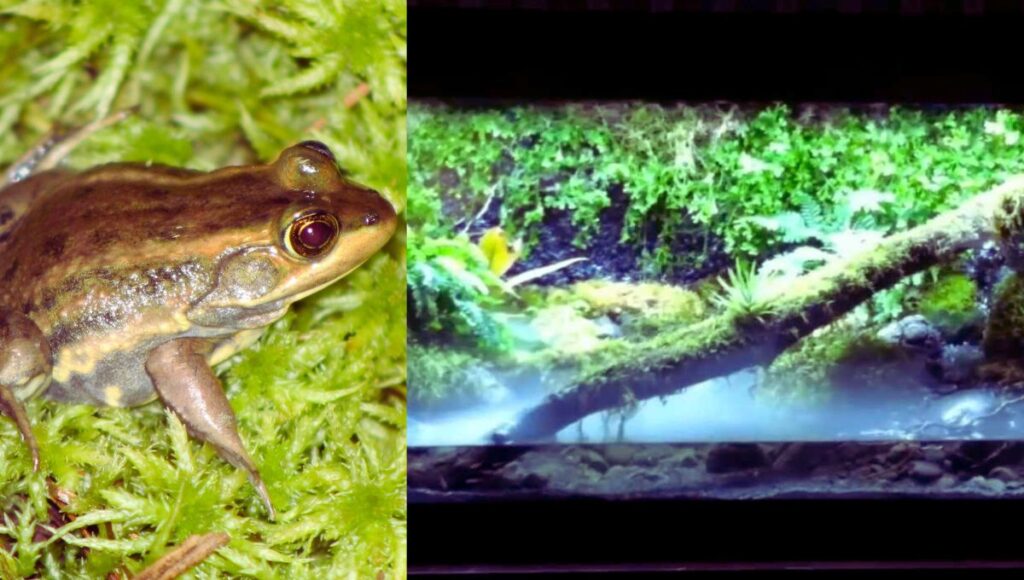
But as their nickname suggests (Sphagnum frogs), the frogs prefer to live in an aquatic area where sphagnum moss is found in high abundance. Hence, you can also use sphagnum moss in the terrarium as a substrate because they are widely used, lightweight, friendly with the frogs, easy to use and clean, can hold moisture for a long time, and you don’t need to change them for a long time. Ensure, the substrate is at least 2 inches thick because it’ll allow the frogs to burrow.
Temperature and Humidity:
Carpenter frogs need warm and highly humid conditions to survive. These frogs need 75-85°F temperature during the daytime and at night the temperature should be a little cooler. However, you also need to adjust the humidity level between 80 and 100 per cent because they can’t survive in a drier environment.
To monitor the temperature and humidity level, you must have a digital hygrometer and thermometer (all in one) with an LCD so that you can understand the readings easily. In case, the temperature of the enclosure goes down, use a heat lamp or heat mat to increase it but avoid overheating. Also, you can use a fogger to maintain the humidity or you can sprinkle water several times a day to control the humidity level.
Light:
Like other native American frogs, Carpenter frogs also need a 12-hour light circle to regulate their daily activities. You may use a low-wattage fluorescent bulb or UVA/UVB bulb to give them enough light. However, UVA/UVB bulbs provide the frogs not only with the missing vitamin D that they don’t receive from sunlight but also help in keeping the enclosure warm.
Food and Supplements:
Carpenter frogs are carnivorous by nature and tadpoles are omnivorous. You can feed the adult one every other day to prevent obesity but the tadpoles must be fed daily. The quantity of food required completely depends on their age, sex, size, health condition, and appetite level.
Usually, you need to feed the adult 3-4 gut-loaded crickets, wax worms, mealworms, super worms, spiders, and other insects every other day. You also provide them with dechlorinated water which is slightly acidic. You can use peat or sphagnum moss in the water filter or add very little baking soda (sodium bicarbonate) to make the water a little acidic (pH=6.5-6.8). Once a week, dust their food with calcium and vitamin supplements to provide them with proper nutrition that they usually cannot get from food.
Cleaning:
You must be very careful about cleaning the tank regularly to prevent any kind of bacterial or fungal growth. On a regular basis, cleaning the water dish, dead insects, waste food, and other waste of live plants is needed, or fungal growth is possible in that wastage. Once a month deep clean the tank with a mild disinfectant and rinse it thoroughly with dechlorinated water. Change substrate whenever it is necessary (if smells bad).
Handling:
Being solitary by nature, Carpenter frogs don’t like being handled by humans. If you touch them unnecessarily, it’ll cause stress to the frogs. You can touch and pick them while cleaning the tank and put them in a different container but unnecessary touches cause stress to them and they release toxic chemicals from their skins. Hence, wear gloves and wash your hands with soap before and after touching the frogs.
You must respect your pet frog’s likings and dislikings and don’t do anything that causes stress to them. Because a stressed frog lives much less than happy and healthy frogs. With proper care and nutrition, Carpenter frogs can live up to 6 years in captivity.
FAQs:
Can you keep two or more Carpenter frogs in the same tank?
It is advised not to keep two or more Carpenter frogs in the same tank. However, it is unknown whether these frogs are cannibalistic by nature but solitary. Hence, if you keep two or more frogs in the same container, ensure they have enough space between them. Also, try to keep similar-sized frogs together to prevent any kind of cannibalism.
Can you keep a Carpenter frog with another species of frogs or amphibians?
It is better if you don’t keep two different species of frogs together in the same tank, and Carpenter frogs are no exception. These frogs release a toxic chemical from their skins that can harm other frogs or amphibians. Also, if you keep them with other frogs such as bullfrogs, green frogs, pig frogs, or other bigger frogs, then your Carpenter frogs might be killed by the bigger frogs.
Reference: Carpenter Frog from Wikipedia
Also Read: Is American Bullfrog Banned as Pet? Top 11 Differences with African Bullfrog
Also Read: Are Pickerel Frogs Good Pets for Beginners? Everything About the Alluring Creature
Also Read: Are Barking Tree Frogs Good Pets for Families or Beginners? A Perfect Pet Guide